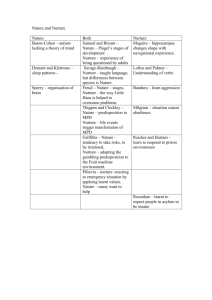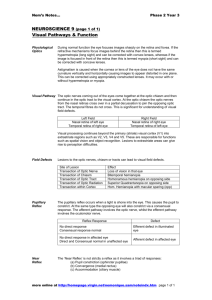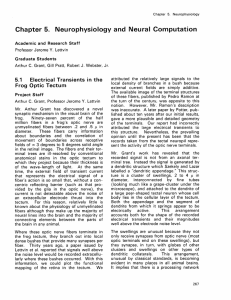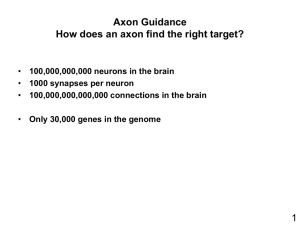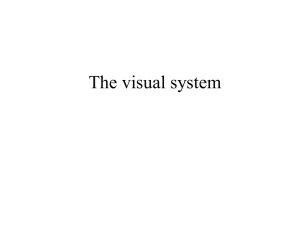Atypical Visual Development in Infants at Risk for Autism Spectrum
advertisement
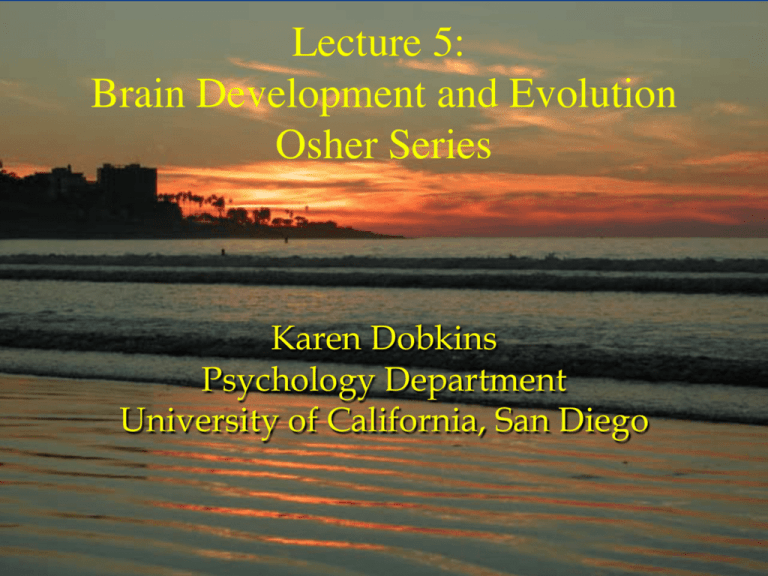
Lecture 5: Atypical Visual Development in! Brain Infants Development andfor Evolution at Risk ! Osher Series Autism Spectrum Disorders (ASD)! Karen Dobkins! Karen Dobkins Psychology Department Psychology Department! University California, Diego University of of California, SanSan Diego! Funded by:! !Autism Speaks / The M.I.N.D. Institute ! !and NICHD (R01 HD052804-01)! Lecture Outline 1) Overview of Neural Development 2) Stages of Neural Development 3) The Nature vs. Nurture Issue 4) Path-Finding by Axons (Nature) 5) Modification of Development by Sensory Experience (Nurture) 6) Brain Evolution 7) Brain Size & Intelligence Development of the Nervous System (NS) “Pre-natal” vs. “Post-natal” Pre-natal terms: Gestation: period of time between conception and birth, i.e., pregnancy Embryonic: early prenatal development Fetal: late prenatal development Brain Development During Gestation / At Birth At Birth = 350g, At 1 year = 1000g (adult = 1,200 to 1,400g) Stages of Brain Development during Gestation 1) Proliferation: Mitosis (division) of Neural Stem Cells 2) Migration: New cells migrate outwardly towards the cortical surface. (Along radial glia) 3) Differentiation: Axons and dendrites formed. Cells differentiate into different neuronal types. 4) Myelination: begins in the spinal cord, then the hindbrain, midbrain and forebrain 5) Synaptogenesis HUMAN BRAIN DEVELOPMENT: Prenatal to 12 years Percent of Adult Level! * but, reorganization of synapses occurs throughout life…. which is LEARNING Nature vs. Nurture Issue NATURE -> pre-programmed (genetic) …. not affected by experience NURTURE -> shaped by environment and experience How does this map onto PRE- and POST- Natal Development? PRE-NATAL development NATURE … because it cannot be modified by sensory experience ??? POST-NATAL development NATURE NURTURE Lower species (e.g., slugs): mostly nature Higher Species (e.g., humans): nature & nurture Functional Explanation (predictability of lifestyle, age to adulthood) Brain Size: Nature or Nurture? MZ (identical) twins DZ (fraternal) twins The MZ vs. DZ comparison provides evidence for Nature, …… but the non-perfect correlation in MZ data suggests that Nurture may ALSO influence. NATURE: Path-Finding by Axons How do neurons know where to project to during development? Genetically-encoded “Chemical Markers” direct them Roger Sperry, 1943: Studied Visual Projections in Adult NEWTS IMPORTANT: Sometimes can do brain experiments in adult animals to learn about development! Retina, Optic Nerve & Optic Tectum in NEWTS (Amphibian) If cut Optic Nerve (CNS!) in some non-mammals (fish, amphibia, reptiles and birds) it regrows, forms new projections/connections, and animal can SEE again. Optic Nerve Retina Retina Oh no, don’t let these connections confuse you about what you learned in Osher 2012! Difference between Amphibia and Mammals!! * Called “Superior Colliculus” in Mammals Local (Specific) Connections from Retina -> Optic Tectum If cut Optic Nerve and rotate eye by 180 degrees, the “old-ventral” area of the Retina grows to the dorsal Optic Tectum. Eye Rotated! WORLD IS NOW UPSIDE DOWN! Sperry’s studies told us that there must be something “chemical” that directs projections from one part of the Retina to a specific part of the Optic Tectum Evidence for Chemical Markers (in vitro experiments) TOPDV, high concentration in Dorsal Retina, low in Ventral Retina AND high in Ventral Tectum, low in Dorsal Tectum ….. forms a chemical gradient There is a different chemical marker for anterior/posterior NURTURE: Examples of Modification by POST-NATAL Experience 1) Raise animals in “Vertical Lines” environment 2) Animals raised in “enriched” environment have greater dendritic branching than those raised in “impoverished” environment. 3) Auditory cortex in deaf people And…visual cortex in blind people Sagittal Evolution of the Brain Similarities across animals: Neurotransmitter types Differences across animals: Dominance of functional areas For example, Human and Non-Human Primates: large visual areas Dolphins and Bats: large auditory areas Raccoons: large “somatosensory” areas As move up evolutionary tree….. Greater task challenges: Need Bigger Brain (more invaginations to increase surface area) Need Relatively More Prefrontal Cortex Brain Size & Intelligence: Is there a correlation? Use Brain-to-Body Mass Ratio rather than overall Brain Mass. - for your body size, how big is your brain? Humans > Apes > Dolphins >>>>> Frogs Complications: 1) Should blubber count in body mass value? Whales? Humans? 2) How to measure intelligence in animals? 3) How to measure intelligence in HUMANS? MRI study (Willerman et al., 1991) Brain-to-Body Ratio 20 students, IQ > 130 20 students, IQ < 103





